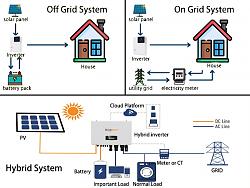▶On-Grid System
Also known as the grid-tied, this type of solar system will generate energy only when its connected to the electrical grid.
The grid-tied inverter will receive Direct Current (DC) from the solar panels and convert it to Alternating Current (AC) to power the house appliances. But, it needs the grid to replicate the wave, frequency, and voltage of the current flowing into your house. This is why it only works when power from the electrical grid is available.
In case of a power outage or unavailability of grid power, the solar system will stop working entirely.
During the nighttime, or when solar panels are not generating enough power, the electrical grid can compensate for the demand. On the other hand, if excess energy is being generated through the solar panel and a net meter is available, it is sent back into the utility grid.
▶Off-Grid System
The off-grid systems are fully independent of the grid as they are equipped with battery backup. The inverter charges the battery and runs the home appliances during the daytime. At night time or during power outages, the stored power can be used.
Off-Grid systems allow you to choose whether the solar panels charge the battery first or power the house. This type of solar installation can benefit remote or rural areas that experience frequent power cuts, but get sunlight all year round.
However, there are some disadvantages. When the panels arent as efficient due to cloud cover, rain or shade, etc. and the battery backup runs out, there is no power. For this reason, people generally install the off-grid system along their standard electricity connection to the grid.
▶Hybrid system
Hybrid solar systems is connected to the utility grid and has an attached battery to store excess energy.
When the electrical power from the grid is available, the solar inverter will work as an on-grid inverter. When power fails, it will work like an off-grid inverter.
The chief benefit of the hybrid system is the availability of power in all situations. During the daytime, the panels will first power the home devices, while using the excess energy to charge the battery. In case there is a surplus, it is sent back to the utility grid.
The stored power can be used during the night when sunlight is not available. Moreover, when the generation is low and the battery is fully discharged, the power from the grid can work as a backup.






 Reply With Quote
Reply With Quote
Did you like this article? Share it with your favourite social network.